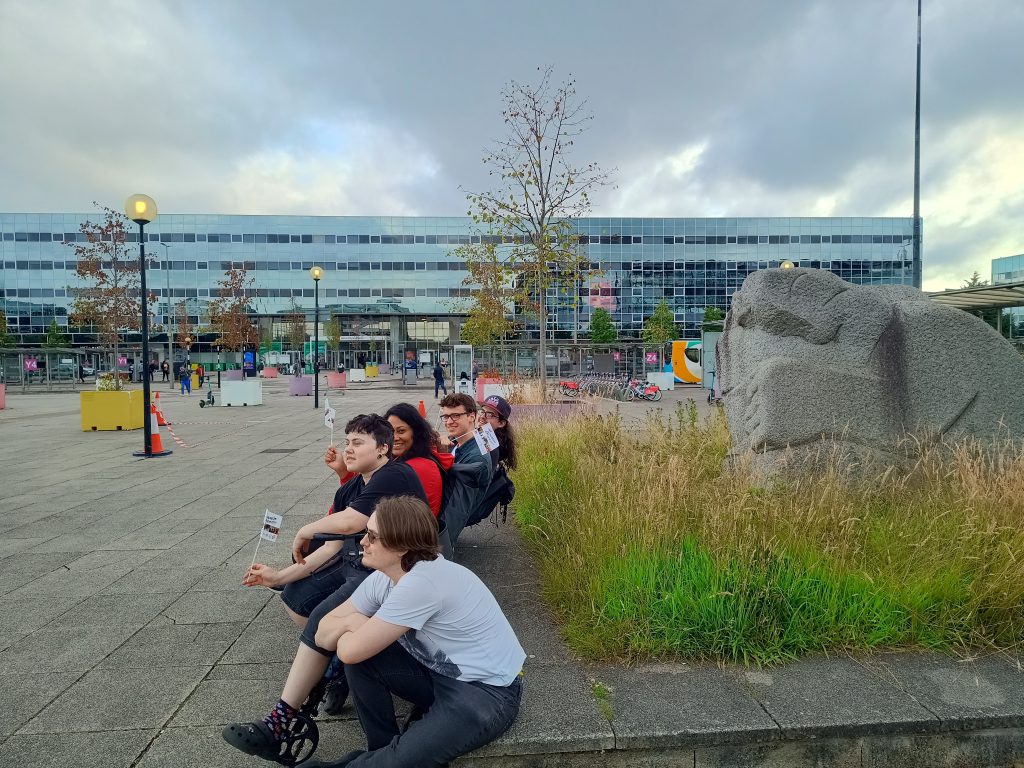A piece created by Matt Dixon, as part of our partnership with Milton Keynes Museum, and their Museum for a New City Project. The below is an account of one of our workshops, which took the form of a guided walk around CMK.

A long walk with good friends and great food – a walk through the sprawling metropolis that is Milton Keynes with bright summer weather – you couldn’t ask for anymore.
We started at the sleek, gleaming Train Station in Central Milton Keynes, first opened in 1982 by Prince Charles and Lord Campbell. The old site of Nobby Newport, the iconic steam engine which resided out the front of the station; (insert picture of steam engine, both the old picture of it out the front, but also a modern one from the Museum) the renowned engine was the primary mode of transport that revolutionised travel between Wolverton and StockPort all the way back in 1867, with 30-trips made daily. The Train Station site now boasts a rich cultural history, with shots of Superman IV being filmed there, as well as the surrounding area. Coupled with an excellent art project funded by MK Council, to put dozens of trees in and around the centre, each with their own little corner of history – it felt like a breath of fresh air walking out into the busy station square.
From the Train Station, we moved to the almost secret gardens of Milton Keynes; the Winter Gardens are an iconic location situated slap bang right in the middle of the bustling city, but from looking at them, you’d never expect that! Walking through them, you think you’ve walked into a tropical paradise. With a wide variety of trees and plants from all over the world, it really puts those who claim Milton Keynes is ‘just a bland concrete jungle’ to shame.
Our next stop was the Church of Christ the Cornerstone, which just so happened to coincide with the start of a school prom, which was definitely not expected! A relatively new Church, only being built in 1992 – it’s a real example of the modern image of Milton Keynes, whilst retaining the important cultural heritage that it brings to the area. The church, designed by a local architect, brings the perfect mix of old and new. There was some fabulous modern art and crafts from school children from around the city which really brought together the local feel that makes it part of the community.
Trying to ignore the people arriving in all manner of vehicles, from old cars, to ice cream trucks, to a horse, we ambled around the masses of students, feeling very important as we walked out on the stretched red carpet that clearly wasn’t for us (but we didn’t care!)
From the Market, we marched quickly up (we may have spent a little bit too much time in the tropical garden) to the Milton Keynes Rose, a lovely landmark in the entrance way to Campbell park, the picturesque estate with its lush fields that feels like it goes on for miles (like our very own little Hyde Park). The MK rose is an important part of Milton Keynes as it allows those that deserve to be celebrated to have their own space. We found special events and special people inscribed onto each pillar, although the lack of any LGBTQ pillars is a bit of a disappointment, key events throughout history can be found here, making it a place of learning, but also love. I think the most important pillar we saw on the day was the Bletchley Park pillar, which gave a great deal of information about Alan Turing and his life.
From there, we made our way back into the bustling theatre district. Although it was a Wednesday, you could see that this was really the beating heart of Milton Keynes. The centrepiece of the theatre district really makes Milton Keynes stand out across the Midlands. Although this walk really took it out of us, luckily – there was a lovely restaurant right next door (pretty much Milton Keynes’ food quarter as well) that served some truly delightful dishes, a true banquet was served for us (by our lovely hosts).
All this and more is waiting for you to investigate Milton Keynes, a rich history going back before the 14th century. If you’d like to find more about the history of this bustling city – click the link, and if you fancy it – visit the Milton Keynes museum!

